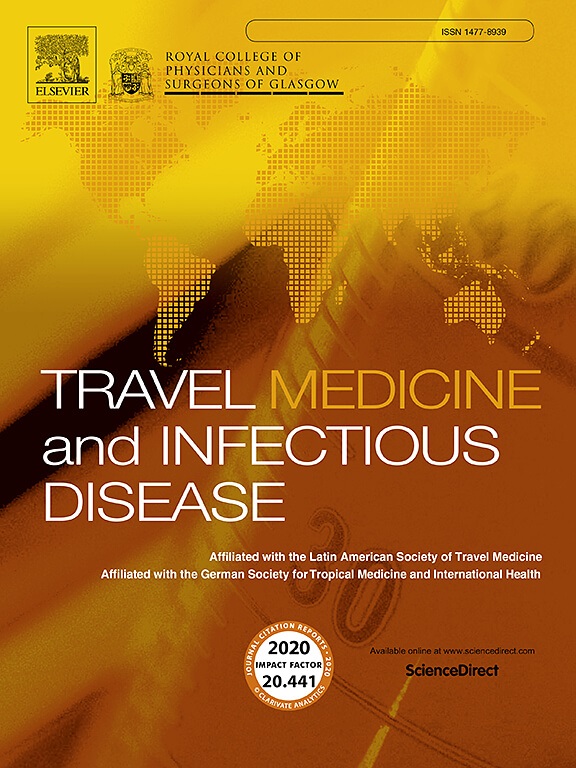First evidence of significant autochthonous transmission of strongyloidiasis in northern Spain: A retrospective study from Asturias, Spain
IF 4.7
3区 医学
Q1 INFECTIOUS DISEASES
引用次数: 0
Abstract
Background
Autochthonous strongyloidiasis in Spain has traditionally been considered a recognized but underdiagnosed condition, primarily affecting individuals in agricultural environments along the Mediterranean coast. We describe the first series of autochthonous strongyloidiasis cases diagnosed in Asturias, a region in northern Spain with no previously documented endemic transmission.
Methods
This is a retrospective review of all diagnosed cases of autochthonous strongyloidiasis at the Central University Hospital of Asturias, from 2016 to 2024. Inclusion required no travel history to endemic areas. Clinical records were reviewed for demographic data, symptoms, risk factors, laboratory findings, and treatment outcomes.
Diagnosis was based on stool microscopy, S. stercoralis IgG serology, and polymerase chain reaction.
Results
We identified 33 patients (54.5 % female, mean age 52 ± 20 years). The primary risk factor was residence in a rural area (63.6 %), frequently associated with gardening that was the most common risk factor (57.5 %). Symptoms were reported in 78.7 % of cases, most commonly abdominal pain (46 %) and pruritus (38.4 %). Eosinophilia was present in 33.3 % of cases. Diagnosis relied primarily on serology (71.4 %) and PCR (56.2 %). Stool microscopy detected larvae in only two patients (6 %). Three patients (9.3 %) developed severe forms, including one fatal case.
Conclusions
This study provides strong evidence of ongoing autochthonous transmission of Strongyloides stercoralis in northern Spain, affecting a younger and more gender-balanced population than previously described. Recreational rather than occupational exposure was the predominant risk factor. Routine screening should be considered in autochthonous individuals with eosinophilia or prior to immunosuppressive therapy to prevent severe outcomes.
西班牙北部圆线虫病重要本土传播的第一个证据:来自西班牙阿斯图里亚斯的回顾性研究。
背景:西班牙的本土圆线虫病传统上被认为是一种公认但未得到诊断的疾病,主要影响地中海沿岸农业环境中的个体。我们描述了在西班牙北部阿斯图里亚斯地区诊断的第一批本地圆线虫病病例,该地区以前没有记录的地方性传播。方法:回顾性分析2016年至2024年阿斯图里亚斯中央大学医院所有确诊的先天性圆线虫病病例。纳入研究不需要有去过流行地区的旅行史。临床记录回顾了人口统计数据、症状、危险因素、实验室结果和治疗结果。诊断基于粪便显微镜,粪球菌IgG血清学和聚合酶链反应。结果:33例患者(女性54.5%,平均年龄52±20岁)。主要危险因素是居住在农村地区(63.6%),通常与园艺有关,这是最常见的危险因素(57.5%)。78.7%的病例报告有症状,最常见的是腹痛(46%)和瘙痒(38.4%)。33.3%的病例存在嗜酸性粒细胞增多。诊断主要依靠血清学(71.4%)和PCR(56.2%)。粪便显微镜仅在两名患者(6%)中检测到幼虫。3名患者(9.3%)发展为严重形式,包括1例死亡病例。结论:这项研究提供了强有力的证据,表明西班牙北部存在粪类圆线虫的持续本地传播,影响的人群比先前描述的更年轻,性别更平衡。主要的危险因素是娱乐性而非职业性暴露。在原生嗜酸性粒细胞增多症患者或免疫抑制治疗前应考虑常规筛查,以防止严重后果。
本文章由计算机程序翻译,如有差异,请以英文原文为准。
求助全文
约1分钟内获得全文
求助全文
来源期刊

Travel Medicine and Infectious Disease
PUBLIC, ENVIRONMENTAL & OCCUPATIONAL HEALTH-INFECTIOUS DISEASES
CiteScore
19.40
自引率
1.70%
发文量
211
审稿时长
49 days
期刊介绍:
Travel Medicine and Infectious Disease
Publication Scope:
Publishes original papers, reviews, and consensus papers
Primary theme: infectious disease in the context of travel medicine
Focus Areas:
Epidemiology and surveillance of travel-related illness
Prevention and treatment of travel-associated infections
Malaria prevention and treatment
Travellers' diarrhoea
Infections associated with mass gatherings
Migration-related infections
Vaccines and vaccine-preventable disease
Global policy/regulations for disease prevention and control
Practical clinical issues for travel and tropical medicine practitioners
Coverage:
Addresses areas of controversy and debate in travel medicine
Aims to inform guidelines and policy pertinent to travel medicine and the prevention of infectious disease
Publication Features:
Offers a fast peer-review process
Provides early online publication of accepted manuscripts
Aims to publish cutting-edge papers
 求助内容:
求助内容: 应助结果提醒方式:
应助结果提醒方式:


